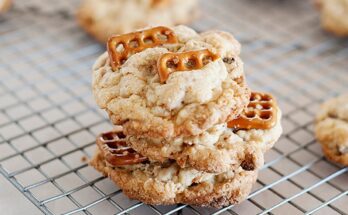Crumpet Recipe: Crumpets are one of those beloved British treats that manage to combine simplicity with irresistible flavor. Think of them as the happy middle ground between pancakes and English muffins. They’re soft, fluffy, and filled with airy holes on top that soak up butter and jam like little flavor sponges. Unlike pancakes, crumpets are cooked only on one side, allowing the top to remain tender and riddled with holes. These circular delights are perfect for breakfast, afternoon tea, or even a cozy snack at night.
Crumpets are usually made with a batter of flour, water, milk, and yeast. They’re poured into metal rings on a griddle or skillet and cooked slowly, allowing bubbles to rise to the top and create their signature texture. The result? A golden-brown base and a chewy, sponge-like top just begging for toppings.
A Brief History of Crumpets
Crumpets have a long and proud tradition in British culinary culture. The earliest versions date back to the 17th century when they were more like hard pancakes. Over the centuries, with the introduction of yeast and later baking soda, crumpets evolved into the soft and spongy treats we know today. By the Victorian era, they became a staple of English tea time.
Interestingly, crumpets were once seen as a “poor man’s” food, simple and affordable. But thanks to their deliciousness, they’ve earned a spot in even the poshest of kitchens. Nowadays, they’re enjoyed across the UK and beyond, with various recipes tweaking the basics to add flavor or texture.
Why You’ll Love Making Crumpets at Home
Here’s the deal—store-bought crumpets just can’t compete with homemade ones. When you make crumpets yourself, you control the ingredients, texture, and flavor. Want them softer? Crisper? More buttery? You’re the boss. Plus, there’s something oddly satisfying about watching those bubbles pop up as they cook. It’s a bit like culinary magic.
Homemade crumpets are also healthier, especially when you avoid the preservatives found in commercial options. And let’s not forget the joy of impressing friends and family with fresh, warm crumpets straight from the pan.
Essential Ingredients for Crumpets
Key Ingredients Breakdown
Here’s what you need to whip up a batch of traditional crumpets:
- All-purpose flour – This forms the base. You could also try bread flour for a chewier texture.
- Active dry yeast – This is what gives crumpets their airy structure. Always check the expiry!
- Warm milk and water – Warm liquids help activate the yeast.
- Salt – Just a pinch, to bring out the flavor.
- Sugar – Feeds the yeast and adds a slight sweetness.
- Baking soda (optional) – Some recipes use a bit of baking soda to add extra fluffiness during cooking.
These ingredients are pantry staples in most kitchens, making crumpets a convenient go-to treat.
Substitutes and Alternatives
Out of milk? No worries. You can use plant-based milk like almond or oat. They might change the flavor slightly, but the texture will remain spot on. Gluten-free flour blends can work too, though you might need to experiment a bit with ratios and liquid content.
Don’t have yeast? Some people try using sourdough starter instead for a more tangy flavor. It takes longer, but the result is totally worth the wait.
Tools You’ll Need
Basic Kitchen Tools
You don’t need anything fancy to make crumpets, but having the right tools makes the job easier:
- Mixing bowls – For mixing and proofing the batter.
- Whisk or hand mixer – To get the batter smooth and lump-free.
- Griddle or non-stick frying pan – A flat surface is best for even cooking.
- Measuring cups and spoons – Precision matters when dealing with yeast.
Optional But Helpful Equipment
- Crumpet rings or egg rings – These help shape the batter and keep it tall and fluffy.
- Spatula – For flipping and removing the crumpets once done.
- Thermometer – Ensures your water and milk are warm, not hot, to activate yeast properly.
Having these tools on hand means less hassle and more consistent results.
Preparing the Crumpet Batter
Mixing and Proofing the Batter
Start by warming your milk and water mixture to about 110°F (43°C). Stir in the sugar and yeast, then let it sit for 10 minutes until frothy. That’s your yeast doing its thing.
Next, mix the flour and salt in a bowl. Pour the yeast mixture into the dry ingredients and stir until smooth. It should look like thick pancake batter. Cover the bowl with a clean towel or plastic wrap and let it rise in a warm spot for about an hour. It should double in size and get nice and bubbly.
Before cooking, dissolve a little baking soda in warm water and stir it into the batter. This gives the crumpets a final boost of rise and that classic texture.
Common Mistakes to Avoid
- Overheating the milk – Too hot, and it’ll kill the yeast.
- Skipping the rise time – This is crucial for getting the right texture.
- Overmixing the batter – You want it smooth, but not overworked.
Take your time with the prep, and your crumpets will turn out like bakery-quality bites.
Cooking the Perfect Crumpets
Stovetop Techniques
Heat your pan on medium-low and grease your crumpet rings. Place them on the pan and pour in enough batter to fill about halfway. Don’t overfill—they’ll rise!
Let them cook slowly for 5–7 minutes. You’ll see bubbles forming and the tops drying out. That’s your cue—they’re doing great. No need to flip them unless you want a crispier top.
When the bottoms are golden and the tops are no longer runny, gently remove them from the rings.
How to Know When They’re Done
Perfect crumpets should be:
- Golden brown on the bottom
- Full of holes on top
- Soft and springy to the touch
Let them cool on a wire rack. They’ll firm up a little as they sit, making them easier to slice or toast later.
Serving Suggestions and Toppings
Classic Toppings
Crumpets are incredibly versatile and can be enjoyed with a variety of toppings. The most traditional way to serve them is toasted with a generous spread of butter. The butter melts into the crumpet’s holes, creating a delightful, rich flavor. For a sweet touch, add jam, honey, or golden syrup on top of the butter.
Savory Options
If you prefer savory flavors, crumpets can be topped with cheese, poached eggs, or smoked salmon. A popular combination is cream cheese with chives or a slice of ham with mustard. These toppings make crumpets suitable for any meal of the day, not just breakfast.
Creative Twists
For a modern twist, consider using crumpets as a base for mini pizzas or open-faced sandwiches. Top them with tomato sauce, mozzarella, and your favorite toppings, then grill until the cheese melts. Alternatively, use them as a base for eggs Benedict, replacing the traditional English muffin.
Storing and Reheating Crumpets
Storage Tips
Homemade crumpets can be stored at room temperature in an airtight container for up to two days. For longer storage, place them in the refrigerator for up to a week. To prevent them from sticking together, separate each crumpet with parchment paper.
Freezing Crumpets
Crumpets freeze well and can be stored in the freezer for up to three months. Place them in a single layer on a baking sheet to freeze individually, then transfer them to a freezer-safe bag or container. This method prevents them from sticking together.
Reheating Methods
To reheat crumpets, simply toast them until they’re warm and slightly crispy. If frozen, there’s no need to thaw them first; just increase the toasting time slightly. Avoid microwaving, as it can make them chewy rather than crispy.
Troubleshooting Common Issues
Flat Crumpets
If your crumpets turn out flat, it could be due to inactive yeast or insufficient rising time. Ensure your yeast is fresh and allow the batter to rise until it’s bubbly and has increased in volume.
Lack of Holes
The signature holes in crumpets are formed by bubbles in the batter. If your crumpets lack holes, the batter may be too thick or not fermented enough. Adjust the consistency by adding a bit more water and ensure adequate rising time.
Sticking to the Rings
To prevent crumpets from sticking to the rings, thoroughly grease the rings before adding the batter. Also, ensure the pan and rings are properly heated before pouring in the batter.
Variations and Flavor Enhancements
Whole Wheat Crumpets
For a healthier version, substitute half of the all-purpose flour with whole wheat flour. This adds a nutty flavor and increases the fiber content.
Herb-Infused Crumpets
Add chopped fresh herbs like rosemary, thyme, or chives to the batter for an aromatic twist. These are excellent when served with savory toppings.
Sweet Crumpets
Incorporate spices such as cinnamon or nutmeg and a bit of sugar into the batter for a sweet variation. Serve with fruit preserves or a drizzle of maple syrup.
FAQs about Crumpet Recipe
1. What is a crumpet made of?
A traditional crumpet is made from a simple batter of flour, water or milk, yeast, sugar, and a pinch of salt. Some recipes include a bit of baking powder for extra lift.
2. What’s the difference between a crumpet and an English muffin?
While both are breakfast staples, crumpets have a spongy texture and visible holes on top, perfect for absorbing butter. English muffins are split and toasted, with a more bread-like texture.
3. Why don’t my crumpets have holes?
Crumpets need a well-rested, bubbly batter and moderate heat. If the batter is too thick or the pan too hot, holes won’t form. Let the batter rise properly and cook slowly.
4. Can I make crumpets without crumpet rings?
Yes, though rings help keep the shape. You can use cleaned tuna cans with both ends removed or silicone egg rings as a DIY alternative.
5. How do I store homemade crumpets?
Let them cool completely, then store in an airtight container at room temperature for up to 2 days, or freeze for longer shelf life. Toast before serving for best taste.
6. Are crumpets vegan?
They can be! Just use plant-based milk and avoid butter or animal fats in the recipe. Check labels if using store-bought crumpets.
7. Can I make crumpets gluten-free?
Yes, with a gluten-free flour blend and a bit of xanthan gum to mimic elasticity. The texture may differ slightly, but they’re still delicious.
Conclusion
Making crumpets at home is a rewarding experience that allows you to enjoy this classic treat fresh and customized to your taste. Whether you prefer them sweet or savory, the possibilities are endless. With a bit of practice, you’ll master the art of crumpet-making and impress your family and friends with your baking skills.



